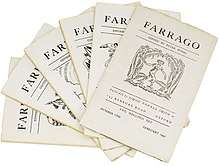Peter Burra
Peter Burra (1909 – 27 April 1937)[1] was a British writer and critic, the author of "The Novels of E. M. Forster".

Early life
Peter Burra and his twin sister Nella Burra were close friend with Peter Pears; Burra and Pears went to school together at Lancing College and then Oxford University. Helen "Nella" Pomfret Burra (1909–1999) was a singer and actress who worked with the Group Theatre productions. She married actor and director John Percival Moody (1906–1993).[2] At Lancing College, both Pears, piano, and Burra, violin, were members of the Lancing Chamber Music Society.[3]
Career
From February 1930 to June 1931, Peter Burra edited the literary magazine Farrago, published by Simon Nowell Smith. They were 6 numbers in total and the cover designs and plates were by Edward Burra, Albert Rutherston, Oliver Holt and Laurence Whistler. In issue 5 there is also an headpiece by Rex Whistler. The magazine published early poems by Evelyn Waugh and Cecil Day-Lewis, plus contributions by A.J.A. Symons, John Sparrow, Max Beerbohm and Lord David Cecil.[4]
Burra was an essayist; in 1934, in "The Novels of E.M. Forster", he was the first to highlight E. M. Forster's highly musical technique of employing textual leitmotifs, which he referred to as "rhythm".[5] He would go on and write the introduction to Everyman edition of A Passage to India (1942), released after his death.[6] E.M.Forster said of him that he was "the best critic of his generation".[7]
Also in 1934, Burra wrote Van Gogh, published by Duckworth, and in 1936, again with Duckworth, he published Wordsworth, Great Lives.[8][9] These two biographies established his reputation as a writer.[7]
Burra was a special correspondent for The Times, and it was while in Barcelona to cover the ISCM Music Festival that he met Benjamin Britten for the first time; in a letter dated 1 May 1936, Burra tells Pears he has also met Britten's close friend Lennox Berkeley. In 1936 Pears was living in Burra's cottage in Bucklebury Common.[2]
Burra was a book reviewer for The Spectator.[10]
In November 1936, Burra reviewed "The Agamemnon of Aeschylus" produced by Rupert Doone with music of Britten; the review appeared in the Group Theatre Paper.[11]
Personal life
Peter Burra was friends with both Peter Pears and Benjamin Britten at different times. Pears lived with him at Bucklebury Common[12] and Britten, while referring to him, used the word "Dear", which was "Britten's blanket term for his intimate friends"; he used the same word in regard to Peter Pears and Lennox Berkeley.[13]
Burra was killed on 27 April 1937, when a light aircraft flown by a friend crashed near Bucklebury Common, Berkshire.[2] It was to have been Peter's first flying lesson. After visiting Spain, and a few days before the bombing of Guernica, he was hoping to help provide air-cover to Republicans.
It was while sorting Burra's personal effects that the relationship between Pears and Britten started.[2]
Legacy
Benjamin Britten wrote an unpublished song, "Not Even Summer Yet", for Peter Pears dedicated to Peter Burra. Pears sang it for the first time accompanied by Gordon Thorne during a concert to the memory of Burra. The song was later revived by tenor Neil Mackle accompanied at the piano by Iain Burnside, at Wigmore Hall, London, on 22 November 1983.[2]
Lennox Berkeley and Benjamin Britten dedicated the orchestral suite, Mont Juic (1937) "In memory of Peter Burra".[2]
References
- "Hyperion". Retrieved 25 September 2017.
- Letters from a Life Vol 1: 1923–39: Selected Letters and Diaries of Benjamin Britten. Faber & Faber. 2011. p. 334. Retrieved 25 September 2017.
- Kildea, Paul (2013). Benjamin Britten: A Life in the Twentieth Century. Penguin UK. p. 152. Retrieved 25 September 2017.
- "Burra, Peter (editor). Farrago". James Cummins Bookseller. Retrieved 25 September 2017.
- Rochlitz, Hanna (2012). Sea-changes: Melville – Forster – Britten: The Story of Billy Budd and Its Operatic Adaptation. Universitätsverlag Göttingen. p. 199. Retrieved 25 September 2017.
- Kundu, Rama (2007). E.M. Forster's A Passage to India. Atlantic Publishers & Dist. p. 204. Retrieved 25 September 2017.
- "Burra (Peter, editor ) – Farrago". Retrieved 25 September 2017.
- "Van Gogh / by Peter Burra". Retrieved 25 September 2017.
- Burra, Peter (1936). Wordsworth. Duckworth. Retrieved 25 September 2017.
- "Review of Coolie: Peter Burra". Retrieved 25 September 2017.
- Letters from a Life Volume 3 (1946–1951): The Selected Letters of Benjamin Britten. Faber & Faber. 2011. p. 68. Retrieved 25 September 2017.
- Pears, Peter (1999). The Travel Diaries of Peter Pears, 1936–1978. Boydell & Brewer. p. 215. Retrieved 29 September 2017.
- "Britten and Berkeley". Retrieved 29 September 2017.